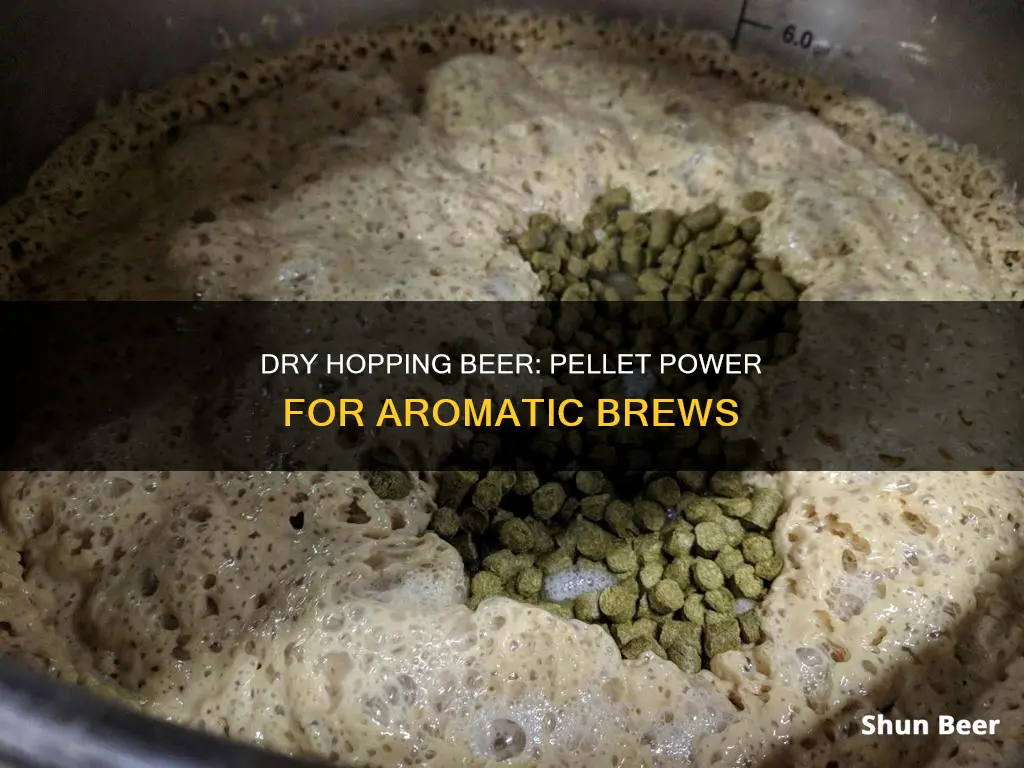
Dry hopping is a process of adding hops to beer during or after primary fermentation. It adds aroma and flavour without any bitterness. The hops can be dried whole leaf or T-90 pellets. Pellet hops are more convenient and readily available. They disintegrate into a hops sludge that sinks to the bottom. A straining bag or strainer will help reduce the amount of hops in your finished beer.
What You'll Learn

Using a straining bag to reduce hops in the finished beer
Using a straining bag is a great way to reduce hops in the finished beer when dry hopping with pellets. This method is especially useful if you want to avoid the hassle of cleaning up loose hops and the potential mess they can create.
The first step is to select a porous bag, such as a muslin bag, and ensure you have enough weights to go in or on the bag. Sanitize both the bag and the weights thoroughly to reduce the risk of infection. Next, choose your favourite variety of hop pellets and measure out ½ to 1 ½ ounces per gallon of beer. Place the hops and weights into the sanitized bag, and you're ready to start dry hopping!
Simply add the bag of hops to your beer in the secondary fermenter and leave it to sit for at least 48-72 hours. This will allow the full flavours and aromas of the hops to infuse into your brew. You can leave the hops in for longer, but be aware that after a few weeks, your beer may start to develop a grassy or oily taste.
Once the desired amount of time has passed, carefully remove the hop bag from the fermenter. Now you're ready to package your beer and enjoy the delicious results of your labour! Using a straining bag makes this process much easier, as it helps to contain the hops and prevent them from ending up in your bottles or keg.
Some brewers choose to dry hop without a bag, but this method can be more challenging and time-consuming. It requires careful siphoning or straining to ensure that the hop mulch doesn't end up in your final product. So, if you're looking for a simpler and more straightforward method, using a straining bag is definitely the way to go.
Growing Beer Hops Indoors: A Step-by-Step Guide
You may want to see also

When to add pellets during fermentation
Dry hopping is the process of adding hops during or after primary fermentation to increase the aroma and flavour of the beer without increasing its bitterness. The hops can be added directly to the fermenter or contained in a bag.
The best time to add pellets depends on the type of beer you are brewing and the results you are looking for.
During primary fermentation
Adding hops during primary fermentation is common practice when brewing IPAs. The active yeast will transform hop oil compounds into new and distinctive floral flavours and aromas. This process is called biotransformation.
However, the bubbling of CO2 and the agitation of the wort during primary fermentation can take away some of the hop aroma from the beer. Therefore, if you choose to dry hop during primary fermentation, you may want to add more hops than you would during secondary fermentation or when dry hopping in a keg.
During secondary fermentation
The secondary fermenter is generally considered the best place for dry hopping. First, the vigorous CO2 activity of the primary fermentation is finished, so the aroma of the hops won’t be scrubbed out of the beer. Second, the alcohol content and low pH of the beer at this stage will help to ward off any bacteria on the un-sanitised hops.
In the keg
Dry hopping in the keg will impart a very fresh taste to the beer as the hops will sit right next to the beer uptake and some of the beer will pass through the hops on its way to your glass. However, the hops should be consumed within 2-3 weeks, otherwise, the beer may develop grassy or vegetal flavours.
How long to dry hop for
Dry hopping can add significant levels of aroma within 24 hours, and this will improve for at least 48-72 hours. The hops can be left in the fermenter for up to two weeks before off flavours start to develop.
Scottish Beers: More Hops or Just a Myth?
You may want to see also

The benefits of dry hopping with pellets
Dry hopping with pellets is a great way to add amazing aromas to your beer. It is a time-honored method with several benefits.
Firstly, dry hopping with pellets is more convenient and accessible for homebrewers. Pellets are easier to work with and can be easily added to most homebrew fermenters. They also take up less space in the fermenter, which means more beer for you! Pellets are also more readily available and have a longer shelf life than whole hops.
Secondly, dry hopping with pellets can help you achieve a more intense and complex flavor profile for your beer. The process preserves the delicate volatile oils in the hops, which contribute to the flavor and aroma of the beer. This results in a beer with a rich, floral, and fruity character, without the harsh bitterness associated with boiled hops.
Thirdly, dry hopping with pellets gives you more control over the intensity of the hop aroma. You can experiment with different varieties and amounts of hops to find the perfect balance for your taste preferences.
Finally, dry hopping with pellets can be a more cost-effective option. Since pellets take up less space and require smaller amounts compared to whole hops, you can save money on your brewing ingredients.
Hops in Beer: Friend or Foe for Sore Throats?
You may want to see also

How to avoid pellet sludge
To avoid pellet sludge when dry hopping beer with pellets, there are several methods you can use:
- Leave your beer in the primary fermenter and dump the hops in loose. This method is recommended by several brewers, who note that the hops will sink to the bottom along with the yeast.
- Use a paint strainer bag tied around your racking cane or autosiphon with a rubber band to keep out the hop sludge as you transfer the beer. Let the bottling bucket sit for a few minutes to allow any remaining hops to settle.
- Use a fine mesh hop bag, muslin, or voile tied around your racking cane/siphon. Boil the bag before use to kill any bugs.
- Use a cut/tied piece of sanitized pantyhose with a sanitized weight. Tie a sanitized string to the top and run it through the blow-off hole, then cork the hole to suspend the hops.
- Cold crash your beer after a few days of dry hopping to cause all the hops to sink to the bottom. Remove the fermentor from the fridge and let it settle before kegging/bottling. You can also use a fining agent like Biofine Clear or gelatin to help clarify your beer.
- Use a 5-gallon paint straining bag over the end of the racking cane to eliminate any hop flakes.
- Use a magnet to suspend a muslin bag of hops above the beer inside a stainless steel fermenter. When fermentation is complete, remove the magnet and the bag will drop into the beer, avoiding oxygen exposure.
- Use a hop bag with a SS bolt, marbles, or other clean and sanitized weights to sink the hops.
- Use a hop dropper to dry hop with zero oxygen. This method requires a fermenter with a stainless steel lid and an opening to hold a tri-clamp fitting. You will need additional parts such as a tri-clamp butterfly valve, tri-clamp spool tube, and a tri-clamp cap with a ball lock post and pressure relief valve.
- Use a Randall or Hop Rocket (hop infuser) to run wort through the hops before it enters the fermenter. This method helps to reduce hop cleanup and achieve biotransformation.
It is important to note that some methods, such as using a strainer bag on the racking cane, may cause clogging and lead to oxidation issues. Additionally, whole hops (cones or leaves) are more prone to oxidation than pellets due to their larger surface area. Weighing down hop bags with clean and sanitized weights can help prevent floating and reduce the risk of oxidation.
Wheat Beer and Hops: An Unlikely Friendship
You may want to see also

How much pellet hops to use
The amount of pellet hops you use will depend on the desired strength of the hop flavour and aroma, the type of hops, and the size of your beer batch.
A standard amount for dry hopping is between 1–2 oz. (28–56 g) of hops for a five-gallon (19-L) batch. However, you can use as little as 0.5 oz. (14 g) for a subtle aroma, or up to 4 oz. (112 g) for a strong aroma. If you are using a hop with a high essential oil content, you may want to use a smaller amount. For your first attempt, it is recommended to use a traditional aroma hop and a maximum of 1 oz. (28 g).
If you are dry hopping in the primary fermenter, you may need to add more hops than you would for dry hopping in the secondary or keg, as the bubbling of CO2 and the agitation of the wort during primary fermentation can reduce the hop aroma.
Smirnoff Flavored Beer: Hops or No Hops?
You may want to see also
Frequently asked questions
Dry hopping is the process of adding hops (dried whole leaf or pellets) during or right after primary fermentation. It adds aroma and flavour without bitterness.
You can use both pellet and whole leaf hops. Pellet hops are more convenient and readily available, whereas leaf hops take up more space and soak up more beer, decreasing yield. Commercial breweries tend to use pellets due to their longer shelf life, efficiency, and reduced beer absorption.
Dry hopping is often done during secondary fermentation, as active primary fermentation can remove delicate aroma compounds. The newest trend, especially with New England-style IPAs, is dry hopping during active fermentation, usually on days 0-5.
For a 5-gallon batch of average strength beer, use one ounce of hops for a general aroma. For more aroma or in higher-gravity beers, you can use up to 4-5 ounces.
When using pellet hops, a straining bag or strainer will help reduce the amount of hops in your finished beer. You can use a muslin bag, a fine mesh hop bag, or a paint strainer bag.







